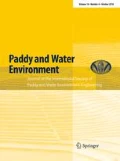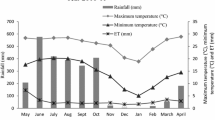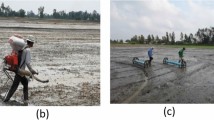Abstract
System of rice intensification (SRI) is an alternate method of conventional puddled, transplanted, and continuously flooded rice cultivation for higher yield, water saving, and increased farmer’s income. The SRI may also have considerable impact on greenhouse gas emission because of difference in planting, water and nutrient management practices. A field experiment was conducted with three planting methods: conventional puddled transplanted rice (TPR), conventional SRI with 12-days-old seedling (SRI) and modified SRI with 18-days-old seedling (MSRI) to study their effect on methane and nitrous oxide emission. Seasonal integrated flux (SIF) for methane was highest in the conventional method (22.59 kg ha−1) and lowest in MSRI (8.16 kg ha−1). Methane emissions with SRI and MSRI decreased by 61.1 and 64 %, respectively, compared to the TPR method. Cumulative N2O–N emission was 0.69, 0.90, and 0.89 kg ha−1 from the TPR, SRI, and MSRI planting methods, respectively. An average of 22.5 % increase in N2O–N emission over the TPR method was observed in the SRI and MSRI methods. The global warming potential (GWP), however, reduced by 28 % in SRI and 30 % in MSRI over the TPR method. A 36 % of water saving was observed with both SRI and MSRI methods. Grain yield in the SRI and MSRI methods decreased by 4.42 and 2.2 %, respectively, compared to the TPR method. Carbon efficiency ratio was highest in the MSRI and lowest in the TPR method. This study revealed that the SRI and MSRI methods were effective in reducing GWP and saving water without yield penalty in rice.




Similar content being viewed by others
References
Bhatia A, Pathak H, Jain N, Singh PK, Singh AK (2005) Global warming potential of manure amended soils under rice–wheat system in the Indo-Gangetic plains. Atmos Environ 39:6976–6984
Bhatia A, Jain N, Pathak H (2013) Methane and nitrous oxide emissions from Indian rice paddies, agricultural soils and crop residue burning in 2007. Greenh Gas Sci Technol 3(3):196–211. doi: 10.1002/ghg
Bouman BAM, Hengsdijk H, Hardy B, Bindraban PS, Tuong TP, Ladha JK (2002) In water-wise rice production. In: Proceedings of the International workshop on water-wise rice production, 8–11 April 2002, Los Banos. International Rice Research Institute, Los Banos
Bouman BAM, Peng S, Castaneda AR, Visperas RM (2005) Yield and water use of irrigated tropical aerobic rice systems. Agric Water Manag 74:87–105
Cai ZC, Xing GX, Yan XY, Xu H, Tsuruta H, Yagi K, Minami K (1997) Methane and nitrous oxide emissions from rice paddy fields as affected by nitrogen fertilizers and water management. Plant Soil 196:7–14
Cai Z, Shan Y, Xu H (2007) Effects of nitrogen fertilization on CH4 emissions from rice fields. Soil Sci Plant Nutr 53:353–361
Chapagain T, Yamaji E (2010) The effects of irrigation method, age of seedling and spacing on crop performance, productivity and water-wise rice production in Japan. Paddy Water Environ 8(1):81–90
FAO (2009) http://www.fao.org/nr/water/infores_databases_cropwat.html. Accessed 11 June 2013
Gujja B, Thiyagarajan TM (2009) New hope for Indian food security? The system of rice intensification. Gatekeeper 143:1–20
Hadi A, Inubushi K, Yagi K (2010) Effect of water management on greenhouse gas emissions and microbial properties of paddy soils in Japan and Indonesia. Paddy Water Environ 8:319–324
Hidayah S, Agustina DA, Joubert MD, Soekrasno (2009) Intermittent irrigation in system of rice intensification, Potential as an adaptation and mitigation option of negative impacts of rice cultivation in irrigated paddy field, Experimental Station for Irrigation Team. Penelitian Irigasi Hemat Air pada Budidaya Padi dengan metode SRI di Petak Tersier, Tasikmalaya (MT 2/2009). Buku 22, Seri Penelitian Irigasi Hemat Air pada Budidaya Padi dengan metode SRI, Balai Irigasi, p 1–11
IPCC (2007) Climate change 2007—the physical science basis contribution of working group I to the fourth assessment report of the IPCC. Cambridge University Press, New York
Jain MC, Kumar S, Wassmann R, Mitra S, Singh SD, Singh JP, Singh R, Yadav AK, Gupta S (2000) Methane emissions from irrigated rice fields in northern India. Nutr Cycl Agroecosyst 58:75–83
Jugsujinda A, Delaune RD, Lindau CW, Sulaeman E, Pezeshki SR (1996) Factors controlling carbon dioxide and methane production in acid sulfate soils. Water Air Soil Pollut 87:345–355
Kosa MK, Sidhu BS, Benbi DK (2011) Methane emission from rice fields in relation to management of irrigation water. J Environ Biol 32:169–172
Krishna A, Biradarpatil NK, Channappagoudar BB (2008) Influence of system of rice intensification (SRI) cultivation on seed yield and quality. Karnataka J Agric Sci 21(3):369–372
Kumaraswamy S, Rath AK, Ramakrishnan B, Sethunathan N (2000) Wetland rice soils as sources and sinks of methane: a review and prospects for research. Biol Fertil Soils 31(6):449–461
MOA, Agricultural Statistics at a Glance (2012). Directorate of Economics and Statistics, Department of Agriculture and Cooperation (DAC), Ministry of Agriculture, Government of India (2012). http://dacnet.nic.in. Accessed 7 Jan 2013
Page AL, Miller RH, Keeney, DR (1982) Methods of soil analysis. Part 2, Chemical and microbiological properties, 2nd edition, Agronomy No. 9, ASA–SSSA Madison
Pathak H, Bhatia A, Prasad S, Jain MC, Kumar S, Singh S, Kumar U (2002) Emission of nitrous oxide from soil in rice–wheat systems of Indo-Gangetic plains of India. Environ Monit Assess 77(2):163–178
Pathak H, Prasad S, Bhatia A, Singh S, Kumar S, Singh J (2003) Methane emission from rice–wheat cropping system of India in relation to irrigation, farmyard manure and dicyandiamide application. Agric Ecosyst Environ 97:309–316
Sharma C, Tiwari MK, Pathak H (2008) Estimates of emission and deposition of reactive nitrogenous species for India. Curr Sci 94(11):1439–1445
Sheehy JE, Peng S, Dobermann A, Mitchell PL, Ferrer A, Yang J, Zou Y, Zhong X, Huang J (2004) Fantastic yields in the system of rice intensification: fact or fallacy? Field Crops Res 88:1–8
Singh JS, Raghubanshi AS, Reddy VS, Singh S, Kashyap AK (1998) Methane flux from irrigated paddy and dryland rice fields and from seasonally dry tropical forest and savanna soils of India. Soil Biol Biochem 30(2):135–139
Sumithde D, Abeysiriwardena Z, Weerakoon WMW, Wickramasinghe WMADB (2009) System of rice intensification (SRI), as a method of stand establishment in rice. Am-Eurasian J Agric Environ Sci 5(2):189–195
Suryavanshi P, Singh YV, Prasanna R, Bhatia A, Shivey YS (2012) Pattern of methane emission and water productivity under different methods of rice crop establishment. Paddy Water Environ. doi:10.1007/s10333-012-0323-5
Tabbal DF, Bouman BAM, Bhuiyan SI, Sibayan EB, Sattar MA (2002) On-farm strategies for reducing water input in irrigated rice: case studies in the Philippines. Agric Water Manag 56:93–112
Thakur AK., Uphoff N, Antony E. (2009) An assessment of physiological effects of system of rice intensification (SRI) practices compared with recommended rice cultivation practices in India. Exp Agric 1–22
Thakur AK, Rath S, Patil DU, Kumar A (2011) Effects on rice plant morphology and physiology of water and associated management practices of the system of rice intensification and their implications for crop performance. Paddy Water Environ 9:13–24
Thiyagarajan TM, Senthikumar K, Sindraban PS, Hengsdijk H, Ramasamy S, Velu V, Durgadevi D, Vogindarajan K, Priyadarshini R, Sudhalakshmi C, Mishra PT, Gayathry G (2002) Crop management options for increasing water productivity in rice. J Agric Resour 7(4):169–181
Tuong TP, Bouman BAM, Mortimer M (2005) More rice, less water—integrated approaches for increasing water productivity in irrigated rice-based systems in Asia. Plant Prod Sci 8:231–241
Uphoff N (2003a) Higher yields with fewer external inputs? The system of rice intensification and potential contributions to agricultural sustainability. Int J Agric Sust 1:38–50
Uphoff N (2003b). Possible explanations for the productivity gains achieved with the system of rice intensification (SRI). In: Thiyagarajan TM, Hengsdijk H and Bindraban PS (eds) Proceedings of an International Symposium on Transition in Agriculture for enhancing Water Productivity. AC & RI, Killikulum, pp 45–70
Yang J, Liu K, Wang Z, Du Y, Zhang J (2007) Water saving and high-yielding irrigation for lowland rice by controlling limiting values of soil water potential. J Integr Plant Biol 49:1445–1454
Zhang H, Zhang S, Zhang J, Yang J, Wang Z (2008) Post-anthesis moderate wetting drying improves both quality and quantity of rice yield. Agron J 100:726–734
Zhang H, Xue Y, Wang Z, Yang J, Zhang J (2009) An alternate wetting and moderate soil drying regime improves root and shoot growth in rice. Crop Sci 49:2246–2260
Zhao LM, Wu LH, Li YS, Animesh S, Zhu DF, Uphoff N (2010) Comparisons of yield, water use efficiency, and soil microbial biomass as affected by the system of rice intensification. Commun Soil Sci Plant Anal 41:1–12
Zheng-Qin X, Guang-Xi X, Zhao-Liang ZHU (2007) Nitrous oxide and methane emission as affected by water soil and nitrogen. Pedosphere 17(2):146–155
Zou J, Houng Y, Jiang J, Zheng X, Sass RL (2005) 2-Year field measurement of CH4 and N2O emissions from rice paddies in China: effects of water regime, crop residue and fertiliser application. Glob Biogeochem Cycle 19:2021–2029
Author information
Authors and Affiliations
Corresponding author
Rights and permissions
About this article
Cite this article
Jain, N., Dubey, R., Dubey, D.S. et al. Mitigation of greenhouse gas emission with system of rice intensification in the Indo-Gangetic Plains. Paddy Water Environ 12, 355–363 (2014). https://doi.org/10.1007/s10333-013-0390-2
Received:
Revised:
Accepted:
Published:
Issue Date:
DOI: https://doi.org/10.1007/s10333-013-0390-2




